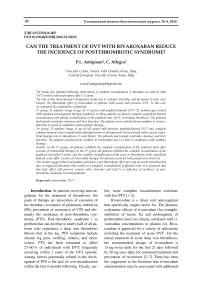Can the treatment of DVT with rivaroxaban reduce the incidence of postthrombotic syndrome?
Автор: Antignani P.L., Allegra C.
Журнал: Ульяновский медико-биологический журнал @medbio-ulsu
Рубрика: Клиническая медицина
Статья в выпуске: 4, 2018 года.
Бесплатный доступ
The study was initiated following observation of complete recanalization of thrombus in subjects with DVT treated with rivaroxaban after 1-2 weeks. The aim of this observational retrospective study was to evaluate clinically, and by means of Echo color Duplex, the fibrinolytic effect of rivaroxaban in patients with recent and previous DVT. To this end, we evaluated two populations of patients: 1st group: 31 patients (range of age 52-73 years) with popliteal-femoral DVT (12 months ago) treated with standard anticoagulant therapy (warfarin). In these patients we found a complete superficial femoral recanalization and partial recanalization of the popliteal vein (30 % of residual thrombus). The patients had normal creatinine clearance and liver function. The patients were switched from warfarin to rivaroxaban due to a lack of compliance with warfarin therapy. 2nd group: 22 patients (range of age 65-82 years) with previous popliteal-femoral DVT and complete common femoral veins recanalization (already known or documented) who presented with a recent superficial femoral vein re-thrombosis (1 week before)...
Rivaroxaban, dvt
Короткий адрес: https://sciup.org/14113392
IDR: 14113392 | DOI: 10.23648/UMBJ.2018.32.22692
Список литературы Can the treatment of DVT with rivaroxaban reduce the incidence of postthrombotic syndrome?
- Prandoni P., Kahn S.R. Post-thrombotic syndrome: prevalence, prognostication and need for progress. Br. J. Haematol. 2009; 145: 286–295.
- Ramacciotti E., Volpiani G.G., Davila R., Resende Aguiar V.C., Silveira Magella F.M., Fareed J. Int. Angiol. 2018; 37 (1): 1–3.
- McRae S.J., Ginsberg J.S. Initial treatment of venous thromboembolism. Circulation. 2004; 110: 13–19.
- Ageno W., Gallus A.S., Wittkowsky A., Crowther M., Hylek E.M., Palareti G. Oral anticoagulant therapy: antithrombotic therapy and prevention of thrombosis. 9thed: American College of Chest Physicians evidence-based clinical practice guidelines. Chest. 2012; 141: e44S–e88S.
- Brummel-Ziedins K.E., Orfeo T., Gissel M., Mann K.G., Rosendaal F.R. Factor Xa generation by computational modeling: an additional discriminator to thrombin generation evaluation. PLoS ONE. 2012; 7: e29178. DOI: 10.1371/journal.pone.0029178.
- Bauer K.A. Pros and cons of new oral anticoagulants. Hematology. 2013; 7: 465–470.
- Allegra C., Antignani P.L., Kalodiki E. News in Phlebology. Torino: Minerva Medica Ed.; 2013: 55–58.
- Allegra C., Antignani P.L. Does rivaroxaban have a fibrinolytic effects? Acta Phlebol. 2015; 16: 107–109.
- Einstein Investigators, Bauersachs R., Berkowitz S.D. Oral rivaroxaban for symptomatic venous thromboembolism. N. Engl. J. Med. 2012; 363 (26): 2499–2510.
- Einstein-PE Investigators, Büller H.R., Prins M.H. Oral rivaroxaban for the treatment of symptomatic pulmonary embolism. N. Engl. J. Med. 2012; 366 (14): 1287–1297.
- Rodriguez R.A., Carrier M., Wells P.S. Non-adherence to new oral anticoagulants: a reason for concern during long-term anticoagulation? J. Thromb. Haemost. 2013; 11 (2): 390–394.
- Weitz J.I., Gross P.L. New oral anticoagulants: which one should my patient use? Hematology Am. Soc. Hematol. Educ. Program. 2012; 2012: 536–540.
- Garabon J.J., Boffa M.B. Impact of Thrombomodulin and Thrombin-activatable Fibrinolysis Inhibitor on the Anti-coagulant and Pro-fibrinolytic Effects of Rivaroxaban Arteriosclerosis. Thrombosis and Vascular Biology. 2016; 36: A34.
- Alvarez E., Paradela-Dobarro B., Raposeiras-Roubin S., Gonzalez-Juanatey J.R. Protective, repairing and fibrinolytic effects of rivaroxaban on vascular endothelium. Br. J. Clin. Pharmacol. 2018; 84: 280–291.
- Lau Y.C., Xiong Q., Shantsila E., Lip G.Y.K., Blann A.D. Effects of non-vitamin K antagonist oral anticoagulants on fibrin clot and whole blood clot formation, integrity and thrombolysis in patients with atrial fibrillation. J. Thromb. Thrombolysis. 2016; 42: 535–544.
- Cheung Y.W., Middeldorp S., Prins M.H., Pap A.F., Lensing A.W., TenCate-Hoek A.J. Post-thrombotics yndrome in patients treated with rivaroxaban or enoxaparin/vitamin K antagonists for acute deep-vein thrombosis. Apost-hoc analysis. Thromb. Haemost. 2016; 116: 733–738.
- Einstein-PE Investigators, Büller H.R., Prins M.H., Lensin A.W., Decousus H., Jacobson B.F. Oral rivaroxaban for the treatment of symptomatic pulmonary embolism. N. Engl. J. Med. 2012; 366: 1287–1297.
- Vanes J. Clot resolution after 3 weeks of anticoagulant treatment for pulmonary embolism: comparison of computed tomography and perfusion scintigraphy. J. Thromb. Haemost. 2013; 11: 679–685.
- Koitabashi N., Niwamae N., Taguchi T., Ohyama Y., Takama N., Kurabayashi M. Remarkable regression of massive deep vein thrombosis in response to intensive oral rivaroxaban treatment. Thromb. J. 2015; 13: 13.
- Kuznetsov M.R., Sapelkin S.V., Boldin B.V., Leont’ev S.G., Neskhodimov L.A. Recanalization of lower-limb deep veins as an index of efficacy of treatment for acute venous thrombosis. Angiol. Sosud. Khir. 2016; 22: 82–88.


